The world is at a turning point when it comes to energy consumption in the post-COVID world and there is increasing traction toward renewable energy sources such as solar power. The United States is a vast country with varying degrees of solar potential depending on the state. For this alone it is vital to know which states offer the best opportunities for solar panel installations. The Database of State Incentives for Renewable Energy finds out the solar potential of the state and also gathers information regarding solar incentives available in each state. This makes us decide which state is the best state for solar energy in the United States. Because let’s be honest the easier and more accessible solar energy is; the more likely people are going to invest in it.
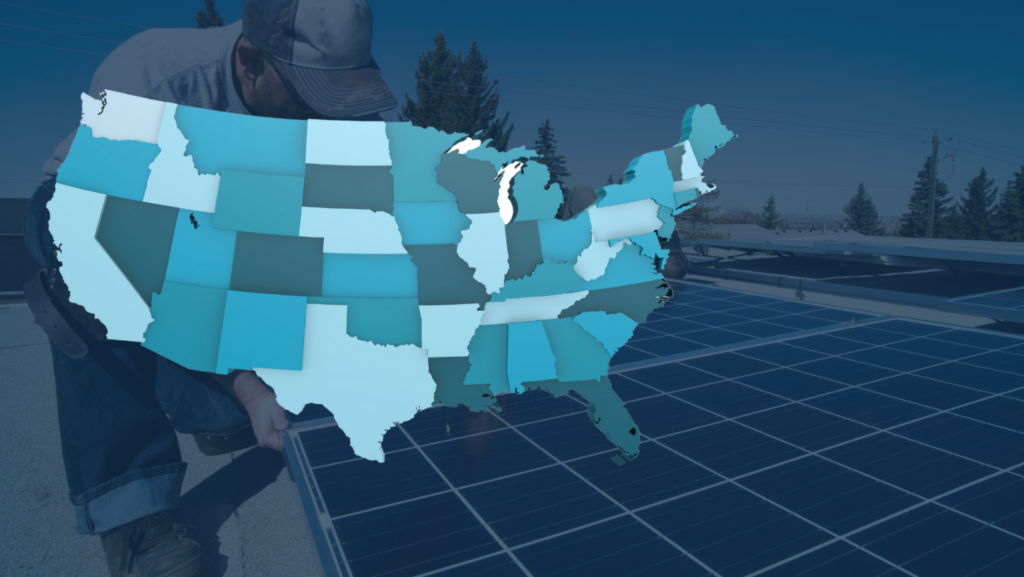
This article aims to provide an in-depth look at some of the best states for solar energy, including their regulatory environments, tax incentives, and net metering policies. With the growing need for sustainable energy, harnessing the power of the sun is becoming an increasingly popular choice for residential and commercial alike.
Check out the Estimated Solar Cost of your home INSTANTLY!
Its 100% FREE
You can have a quick idea about the cost of switching to solar
Our Energy professionals are one call away for advice
Important Points To Remember
- According to Forbes Homes, survey, 48 percent of US residents want to install Solar panels in the future.
- According to Solar Energy Industries Association (SEIA) quarterly report the best states for solar energy are California, Texas, North Carolina, Florida, and Arizona.
- California receives nearly 300 sunny days, has a robust solar system, a stable job market, and a massive investment in solar space.
- Texas is leading the way in residential solar production. Approximately 1,855,828 homes use solar energy to power their home in 2023.
- The Average Cost of Installation of solar panels in North Carolina after a 30% Federal Tax Credit is $10,390.
- To promote the culture of green and sustainable solar energy General Motors is making investments in solar farms near the Bowling Green Area of Kentucky.
What's in this Article?
What are the Five Best States for Solar Energy Production?
According to Forbes Homes, survey, 48 percent of US residents want to install Solar panels in the future. However, concerns like upfront cost, the return on investment, and navigating local regulations were the common dominator factors that homeowners fear before going solar. The fact is not deniable that some states are better than others when it comes to incentivizing and supporting solar panels. And their geographical placement is also quite better than the other states hence increasing their solar potential by state record. According to Solar Energy Industries Association (SEIA) quarterly report, the following are the best states for solar energy production.
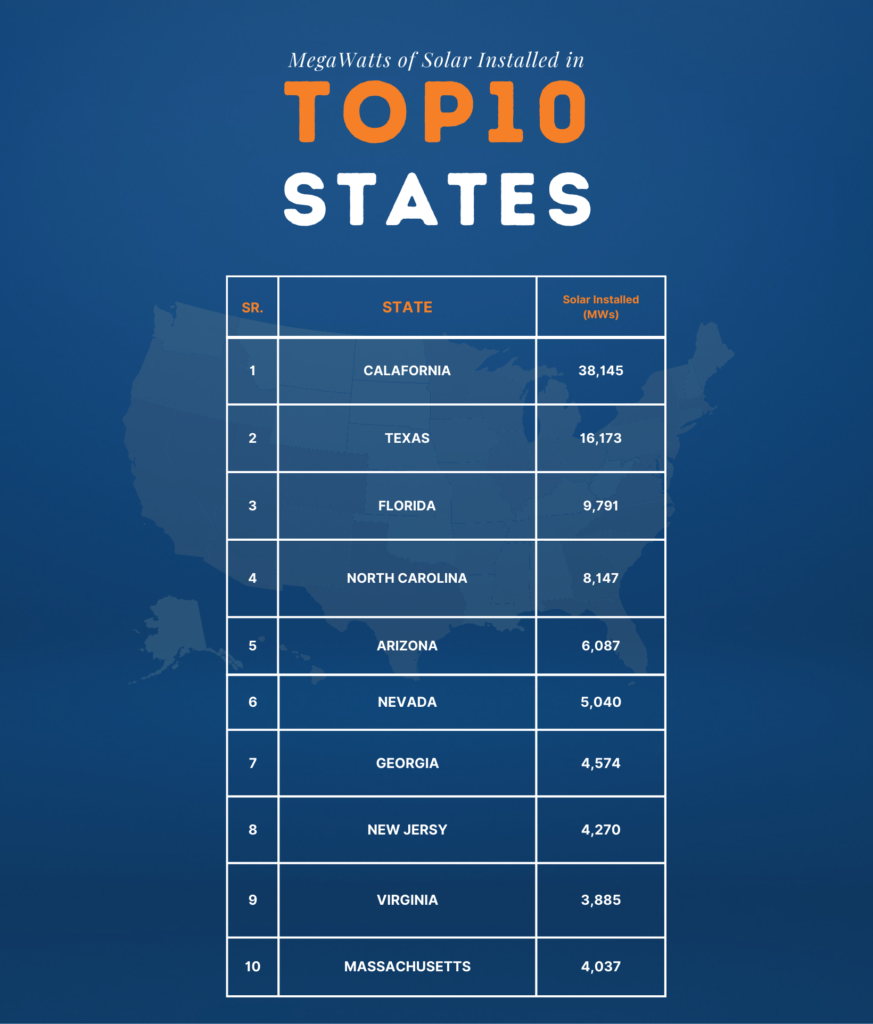
1. California:
The golden state top the list due to its compatible nature to harness solar energy. California is among the best state for solar energy production because of its 300 sunny days or near sunny days, robust solar system, stable job market, and massive investment in solar space. Almost twenty-five percent of California’s electricity comes from solar energy. Moreover, the state has invested approximately seventy-five billion dollars in solar technology.
According to the SEIA report, the residential solar installation has topped off the previous solar panel installation with 1.57 gigawatts worth of solar installation in a single year. Out of this total installation, 36% of the installation takes place just in the Golden State. When it comes to megawatts installation, California leads the way here too. With 38,144 MW of power production, the state comes first in the line of the best states for solar energy.
California's New Net Metering Policy
According to an estimation, in 2024 the annual solar installations will reach up to 30 to 40 gigawatts in the United States. And California will be the state to drive the record volumes in this regard. This will happen because the solar industry in California will rush to get the sales up before the state shift to new net metering policies. However, California was the first state to incentivize renewable energy in 1976, making it the best state for solar energy production. Currently, the state contains 2,000 solar companies and 10,510,648 homes that use solar energy to power their homes.
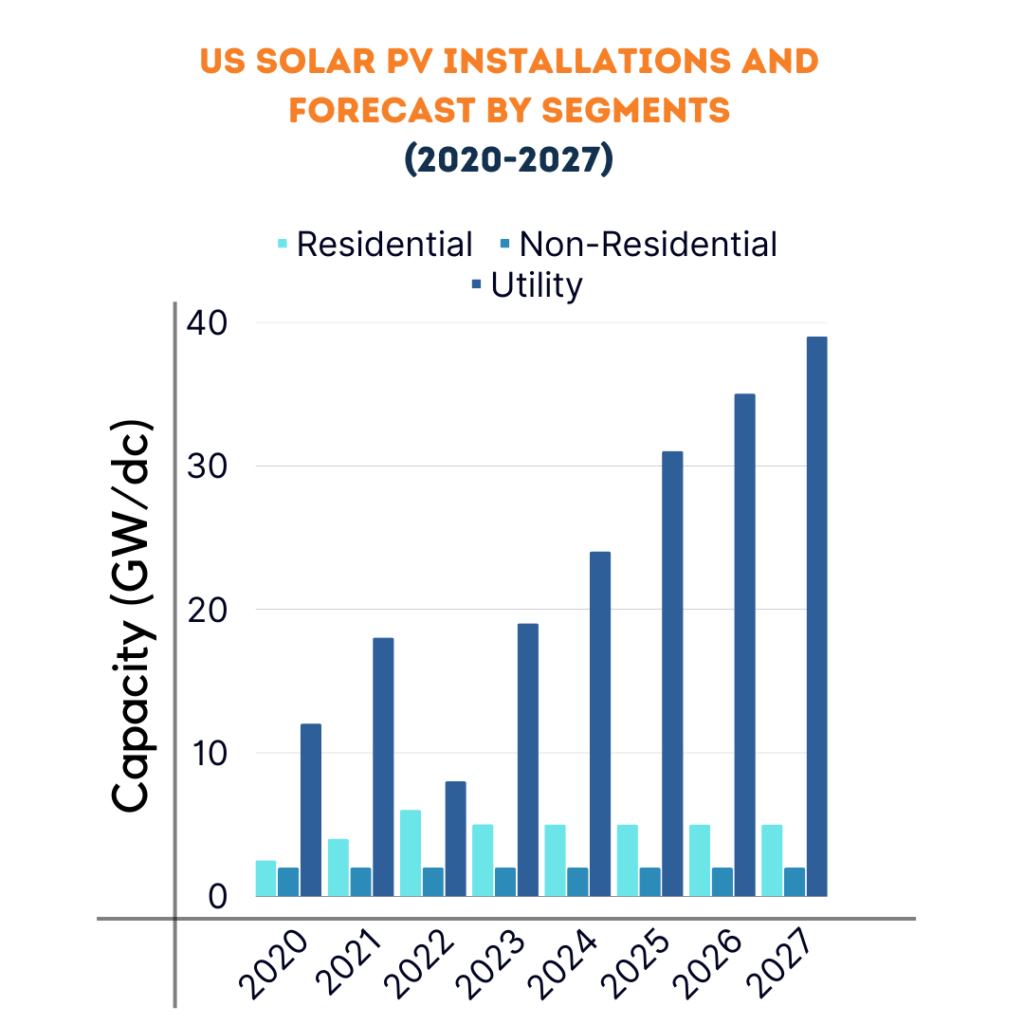
2. TEXAS:
The Lone Star State is also among the best states for solar energy. In Texas 16,173 MW of solar installation take place last year. Texas is leading the way in residential solar production. Out of total electricity production in Texas, 4.7 percent comes from solar energy. Approximately 1,855,828 homes use solar energy to power their home. Texas is likely to invest fourteen billion dollars in solar energy. This will increase the solar capacity of Texas to almost 1,525 megawatts. Which is almost 45 % more than the last year. The Lone State also receives 135 clear sunny days for solar energy production. Hence increasing the state potential of solar production. The solar industry of Texas also offers 10,346 jobs to its citizen. According to SEIA the US solar PV modules forecast from 2020-2027 is as follow:
3. North Carolina:
The Mid-Atlantic state is no exception to getting benefits from its geographical location. Due to better geographical placement and state tax incentives, North Carolina comes among the best states for solar energy production. The number of clear sunny days in North Carolina is 109 which improves the solar potential of the state. However, North Carolina contains approximately 8,147 megawatts of solar installation. Almost 9.0% of total electricity production in the state takes place through solar radiation. This amount of energy is enough to power 955,987 homes which in turn makes North Carolina the best place for solar energy production. The average Installation cost of solar panels in North Carolina after a 30% Federal Tax Credit is $10,390. The total solar investment in North Carolina stands at a whopping ten billion dollars.
4. Florida:
It is not surprising that the Sunshine State is among the best places for solar energy production. Almost 5.4 percent of Florida’s energy is run by solar energy. Which is more than enough to power 1,157,337 Floridian’s homes. Thus, making it among the best states for solar panels installation. Currently, in Florida 9,791 megawatts of solar energy are installed. The state has an investment worth $10.5 billion in solar technology. Due to this, the state can offer 11,761 solar jobs, making it the best place for solar energy production. In 2021, an addition of 525 megawatts was made to the total solar capacity of Florida. This has doubled the cumulative solar capacity of Florida in less than a year. The number of clear days in Florida is about 101.
5. Arizona:
Arizona is the sunniest state in the country, receiving 193 clear days for solar power production. The Grand Canyon State has about 306 solar companies which include 57 manufacturers, 144 installers, and 105 non-designate. The solar industry in Arizona is responsible for creating 8,278 solar jobs, making it among the best states for solar energy. Almost 10% of the state’s energy now comes from solar energy alone.
Currently, 953,394 households in Arizona utilize solar energy. Furthermore, Arizona invests heavily in its solar sector as well, which is approximately $14.3 billion. This places Arizona in the second position right after California on the list of best states for solar energy. This makes Arizona the best place for solar panel installation as well, hence increasing the solar potential of the state. According to SEIA the total solar capacity of USA is increasing by the year.
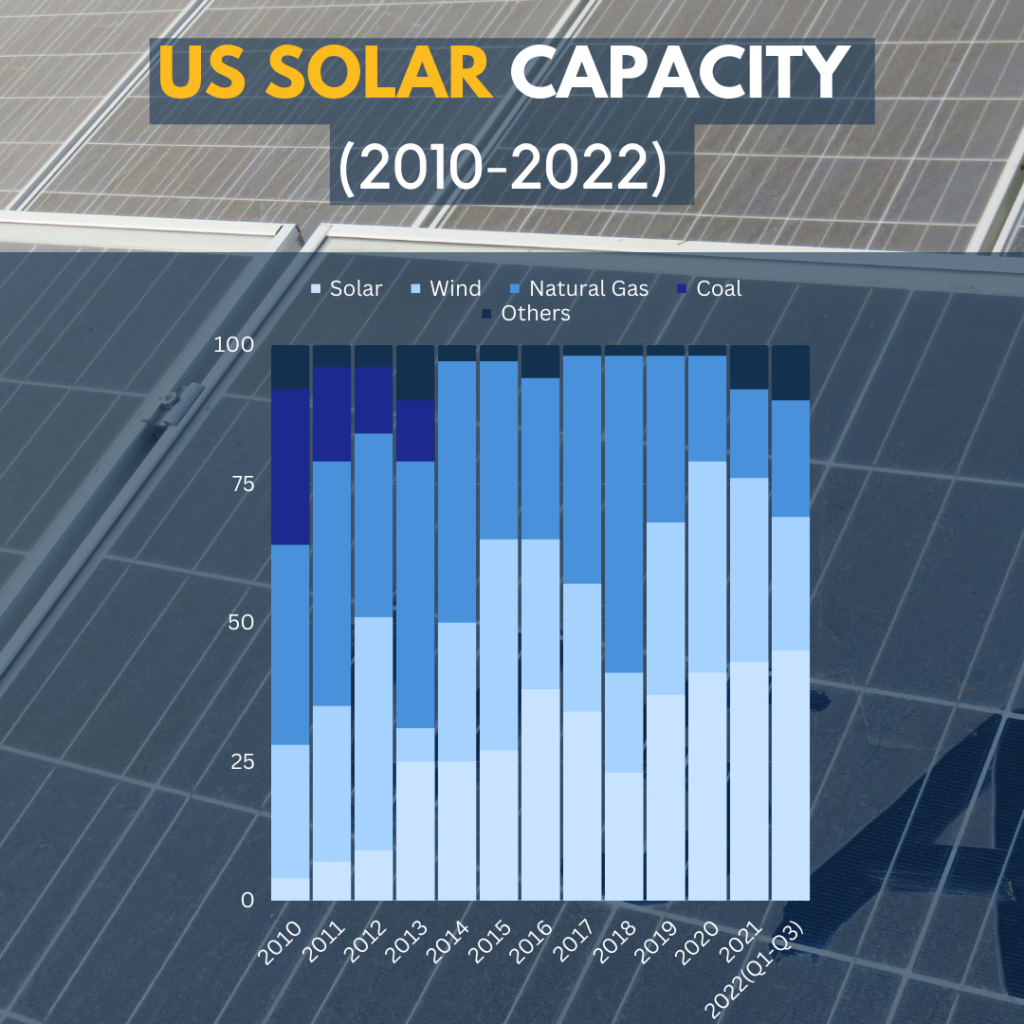
What are the Five Worst States for Harnessing Solar Energy?
While some states gain the advantage over solar energy production with their best geographical location. Some states can never come into the list of best states of solar energy which are as follow:
1. North Dakota:
The state rule by Great Plains is not among the best geographical location for solar energy. North Dakota ranks worst for solar power production. Although the number of sunny days that the Midwestern State receive is 93, which shows a very conducive environment for solar power production. There are only two megawatts of total solar installation exist in the state. This is due to the low population density of the state. Solar energy is currently powering at least 145 homes in North Dakota. The contribution of solar energy to the total energy mix of the state is almost zero percent. This impacts the overall solar job market of the state and does not contribute any clean, solar electricity to the grid as well. Nonetheless, the state investment in the solar industry stands at a whopping three million dollars.
2. South Dakota:
Mount Rushmore State has just ten solar companies, creating almost 479 solar jobs. Solar energy contribution to the total energy mix of South Dakota stands at about zero percent, which is far away from increasing the state’s potential to become the best place for solar energy production. To improve these statistics, the state’s investment in the solar technology field is almost about $4 million. The megawatt of solar installation is similar to its neighbor, North Dakota. But the home installation in South Dakota is almost double when compared to North Dakota, which is 245. The state currently contains 10 solar companies which are responsible for creating 479 solar jobs.
3. West Virginia:
West Virginia is mostly associated with coal mining. The mountain state holds almost 14,000 people link with the coal industry as compared to the 372 solar jobs. That’s why it is quite hard for the residents to shift from coal power energy to renewable energy. The state has just 24 megawatts of solar panels installed. So, we can say that West Virginia is not the best geographical location for solar energy generation. Only 2,211 households utilize solar energy as a way to power their homes and the state receives only 60 days of clear sunny days per annum. Currently, 17 solar companies exist in west Virginia with a solar investment of $49 million.
4. Alaska:
Alaska is facing a disadvantage when it comes to geographical location. Most of the time Alaska is plunged into darkness. Alaska receives only 60 days of clear sunny days per annum. Although the initial cost of solar panel installation in Alaska is about $9,956, which is quite low, still the megawatt of solar installation is just 17MW in the entire state. The state only has 11 solar companies which leads to the creation of only 63 solar jobs. Only 0.2 percent of the state’s electricity comes from solar energy. And only 2,016 homes use solar energy, which automatically impacts the solar potential of the state. Alaska’s state government is trying to bring this potential up with the help of a $39 million solar investment.
5. Kentucky:
Only 0.15% of the total energy in the Bluegrass State comes from solar energy. Despite the initial installation cost of solar panels being low to almost about $9,641. Kentucky solar investment stands at about $137 million but still, the megawatt of solar installation is only 83MW. The total number of houses that use renewable solar energy to run their household is almost 8,035.
Currently to promote the culture of green and sustainable solar energy General Motors is making investments in solar farms near the Bowling Green Area of Kentucky. But many people are hesitant against these industrial solar farms because still now the plantation history of Kentucky is engraved in the heart of many locals. Due to this reason alone, the state only contains 40 solar companies which generate approximately 1,486 solar jobs.
How Solar Incentives Impacts the Solar Potential of the State?
It is known to human history, the more subsidize a product is, the more popular it becomes among the general masses. The same thing applies to solar energy, the main reason behind solar energy’s popularity is that it is not only incentivized at the federal level but also many states will provide certain amenities to solar homeowners. However, understanding your state legislature can help you get a clearer picture of solar panels’ upfront cost and their payback period.
The federal government offers incentives for solar panels which are known as Investment Tax Credits (ITC). ITC currently allows homeowners to claim 30% of the initial installation cost of solar panel systems. Recently it increased from 26% in 2022 to 30%. This will again be reduced to 26% in 2032 and further reduced to about 24% in 2034 unless it is renewed by Congress.
Moreover, some states offer extra incentives when come to solar power. which includes state-based tax incentives, rebates, and Solar Renewable Energy Certificates (SREC). In 2023, Arizona has the best incentives. The Property with a solar system in Arizona is 100 % exempted from property and sales tax. The state also offers a 25%tax credit for the total cost of the solar system.
Conclusion:
Recently, President Joe Biden signed into law the Inflation Reduction Act which includes larger investments in renewable energy and measures to address climate change. Due to this act, 27% of growth in the solar industry is forecasted for 2023-2027. Among the act’s other provisions, there is a specific clause that talks about the 30% solar tax credit extension till 2034. This can spur more Americans to “go solar” over the next decade.
Currently, residential solar power generates just a fraction of the country’s overall electricity, it has continued to grow rapidly in recent years, despite COVID-19-related supply chain issues, import restrictions, and other obstacles. The United States boasts a diverse array of states that will suit well for harnessing the power of solar energy. As society moves towards a greener future and renewable energy, the understanding of the potential of solar energy in these states becomes vital. It is crucial for policymakers, industry leaders, and individuals alike to recognize and prioritize the development and implementation of sustainable energy practices in these top solar states and beyond.
According to Solar Energy Industries Association (SEIA) quarterly report, the United States installed 4.6 gigawatts of solar PV capacity in 2022 alone. Due to this, the total capacity of the US has now reached 135.7 GW of total installed capacity. This amount of electricity is enough to power 24 million American homes. The world currently has a cumulative solar energy capacity of 850.2 GW. According to an estimation, 4.4% of global energy comes from solar power. But for the USA it will take around 18.5 billion solar panels to power the entire country in 2023. There were 514,000 new residential solar systems installed in 2021, a 30% growth rate year on year and they will keep on increasing. Currently, 3.2 million US homes have solar panels installed.
Chinese company LONGi Solar is the world’s largest solar panel manufacturer, producing 14.7 GW of solar capacity according to the Solar Industry Update. Most solar panel manufacturing takes place in China. The top 6 manufacturers are all Chinese. Tongwei (12.1 GW) is the second-largest, and JA Solar (10.8 GW) is third. Moreover, certain Canadian and USA companies are also gaining traction in the solar panel manufacturing field. The largest manufacturer outside China is Canadian Solar with 8.3 GW. And First Solar is the largest manufacturer in the US, with 5.5 GW. Some other well-known solar panel companies with manufacturing facilities in the U.S. include LG Solar, CertainTeed, Q CELLS, Silfab Solar, JinkoSolar, Solaria, and Tesla.
The US has 123 GW of solar capacity. The latest statistics show that 3.9% of US electricity comes from solar power. Solar provided 0.95% of electricity in the US in 2015, and just 0.03% in 2010. This shows how much the solar contribution has increased in the energy mix of the US. The biggest producer of solar energy in the United States is the golden state, California. California has a solar capacity of more than 35.95GW. This type of energy is enough to power more than 8.4 million US residents. California is also among the top state with the fastest payback period for solar energy. If you install a rooftop solar system, you’ll be able to get your money back in 6 years.
But as for 2023 statistics, Texas is the state with the highest number of new solar installations in the US. Which is then followed by California and Florida. Texas and California both have the highest residential solar rates as well as the highest installed solar capacity. This is because of the high insolation, great community support, and the Renewable Portfolio Standard. this portfolio mandates that both states produce up to 60% of their energy from renewables by 2030.
Related Articles:
 What are Renewable Energy Credits (RECs)? Exploring the Benefits for Homeowners & Businesses
What are Renewable Energy Credits (RECs)? Exploring the Benefits for Homeowners & Businesses
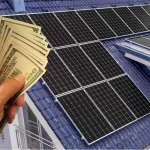 Exploring the Cost of Going Solar in Texas: Finding the Best City for Solar Installations
Exploring the Cost of Going Solar in Texas: Finding the Best City for Solar Installations
 Is it Worth to Install Solar Panels in Arizona? What You Need to Know Before You Go Solar in State?
Is it Worth to Install Solar Panels in Arizona? What You Need to Know Before You Go Solar in State?
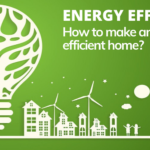 Energy Efficiency: How to Make an Energy-Efficient Home?
Energy Efficiency: How to Make an Energy-Efficient Home?

